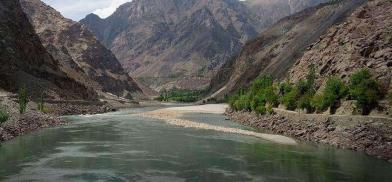The Indus Waters Treaty: Enduring agreement provides security in strained India-Pakistan ties
Today’s dispute (between India and Pakistan) is now less about Kashmir and Kashmiris and more about a river system with its headwaters in Kashmir writes Anuttama Banerji for South Asia Monitor

In these strained times between India and Pakistan, a close look at the Indus Waters Treaty, which has endured the test of time and hostility, could provide a way ahead out of the impasse in ties between South Asia’s largest countries.
Water, the elixir of life, is a scarce resource and water scarcity has led to conflict and violence. States are competing with each to wrest control of water resources. The question of water security has to be viewed in this context.
The relationship between water and society in South Asia is complex because ‘control over water’ is a symbol of socio-political power. Water resources are controlled by the village elites at the local level while, at the level of the nation state, states have asserted their ownership of water resources and built ‘empires of water’ that are linked with national identity and pride. Control of water is based on cultural constructs of water and dams are the traditional symbols of development.
In the 21st century, water security issues have taken a front seat in South Asia. Water resources are a ‘commodity’ rather than a natural endowment in the region and differences over water sharing continue to exist. However, the Indus Waters Treaty (IWT) is an exception and has endured the test of time. It was signed between India and Pakistan in 1960 and it is important to re-examine the IWT and discuss its enduring relevance for India and Pakistan.
The Indus and its tributaries constitute one of the largest river systems in South Asia. The Indus river originates in Tibet and, after flowing through Jammu and Kashmir, enters Pakistan. The waters of the Indus are shared by China, India, Pakistan and Afghanistan. The Indus is part of the shared cultural ethos of both India and Pakistan. The banks of the Indus have absorbed traditions like Buddhism and Islam. The Buddha lived along its banks while Guru Nanak, the founder of Sikhism, attained enlightenment while bathing in the Indus. It is a river that has traversed both history and geography.
The Indus appeared as a political issue when India and Pakistan emerged as two separate states in 1947. The creation of land boundaries was accompanied by the creation of water boundaries. Pakistan felt that it was ‘vulnerably dependent’ on India and a disruption of flows was reported on April 1, 1948, when East Punjab cut off supplies to the canals crossing into Pakistan. Canal water to West Pakistan was restored on April 30,1948 and an ‘Agreement on the Canal Water Dispute’ was signed at the Inter-dominion Conference on May 4, 1948, which recognized East Punjab’s rights to cut off supply to the West, eventually. But the legal viability of the document became an issue with India calling it a ‘treaty’ and Pakistan calling it a ‘statement'. After multiple negotiations, the matter reached the doorstep of the International Bank for Reconstruction and Development (IBRD) or the World Bank after a call was made for early resolution of the conflict.
In February 1954, the World Bank proposed that (a) historic withdrawals must be continued (b) the three eastern rivers be assigned to India and the three western rivers assigned to Pakistan (c) Pakistan would have a transition period of five years to construct link canals to allow replacement of water supplies from the eastern rivers. The Indus was thus ‘officially partitioned’. India accepted the recommendations in March 1954. Pakistan agreed to the recommendations after India agreed to partly finance the construction of replacement works (Tarbela Dam on the Indus and Mangla on the Jhelum, among others)
The Treaty was signed between India and Pakistan in 1960. It stated that India would not store or construct any storage works on the western rivers. India was allowed to use the water of the western rivers for hydro-electricity before the rivers enter Pakistan. A Permanent Indus Commission (PIC) and a dispute settlement mechanism was also established. Overall, Pakistan was allocated 80% of the waters while India had access to 20% of the waters, though India’s historical usage of the Indus and its tributaries stood at 10%.
The Indus river system has, from the beginning, played a role in the evolution of the Kashmir dispute, where the territorial dispute is taking a backseat and river-water issues are now critical. The territorial issue has almost reached a de-facto settlement. Today’s dispute is less about Kashmir and Kashmiris and more about a river system with its headwaters in Kashmir. The raison d’être of Pakistan’s existence is linked to Kashmir not just because of the commonality of religion, but because of the water resources available there. Pakistan wants to derive maximum benefit from the existing status quo while keeping the issue alive at the rhetorical level.
Both India and Pakistan want to utilise the water resources available to them. Both countries have been constructing hydel power projects on the Kishenganga river, a tributary of the Indus. India inaugurated an upstream hydro-electric plant, the Kishenganga Hydroelectric Project (KHP) in 2018, while Pakistan’s China-funded project, called the Neelam Jhelum Hydroelectric Project (NJHP), continues to linger because construction was stalled in September 2011 until a final settlement was reached in the dispute.
Since Kashmir is important for India to fulfil its hydroelectric energy needs, India wants to secure its position there. Pakistan relies on the Indus waters for its survival. Pakistan faces extreme weather conditions that has aggravated the problem of food insecurity. The total population facing food insecurity in Pakistan is around 22.5 %. While people in the federal territory of Punjab are better off, those in Balochistan and Khyber Pakhtunkhwa face critical shortages.
Is revision of the IWT possible today? The answer can be both a ‘yes’ and ‘no’. Ramaswamy Iyer, a scholar, favours joint management of the river waters. He contends that a share of 20% of the water to India was not ipso facto low and that historical usage did not determine a country’s future needs or requirements.
During the 2013 elections, the Pakistani government promised the people that they will work on the agenda of 3Es; the severe energy shortage, the underperforming economy, and the rise of religious extremism. All three promises could be fulfilled , it claimed, if Pakistan flexed its muscles on the IWT issue.
So, can water as an issue be ‘securitized,’ especially keeping the IWT in mind? Iyer says that the answer to this question lies not in defining anything, but by looking at the concerns. He identifies three categories of ‘security’ issues; water needs for diverse purposes (availability, reliability, dependence) the danger posed by floods (need for mitigation, management and damage minimization (prevention or control of pollution and contamination). He argues that states must establish warning systems to counter flood flows. Analyst Undala Z. Alam says if India and Pakistan had followed the “water wars rationale” they should have gone to war, but they did not go to war over the Indus Waters due to “water rationality” i.e. any step taken by a state to secure its water supply in the long term both in quantity and quality. Thus, by signing the IWT, both countries have safeguarded their long-term water supplies from the Indus River Basin.
Joseph Korbel states that Pakistan’s economic interest is attached to Kashmir’s water resources. Had India occupied the lower waters of the three rivers (Indus, Jhelum and Chenab) Pakistan may have been strangulated economically. Sundeep Waslekar highlights Pakistan’s desire to take control over the Chenab river by occupying the Muslim majority areas of Jammu and the prized valley. He says that the battle in Kashmir revolves solely around the question of water.
In hindsight, there is no doubt that the Indus Waters Treaty has enhanced co-operation and security between India and Pakistan and has stood the test of time.
The IWT is both permissive and restrictive towards India. A system of checks and balances exist within the Treaty. As B G Verghese said, the Treaty has “triumphed” because it enhances the chances of dispute resolution between India and Pakistan. It is, therefore, in the mutual interest of both countries to ensure that the Treaty is saved and remains in the current form.
(The writer has a Master’s in International Relations from the London School of Economics)













Post a Comment